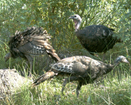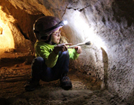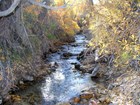The Midden is the Resource Management Newsletter of Great Basin National Park, published each summer and winter. Find out the latest going on at Great Basin National Park, Nevada in resource management and research. The Midden - Great Basin National Park: Vol. 15, No. 1, Summer 2015.
-
Great Basin National Park
Article 1: Alpine Lichens and Climate Change on Wheeler Peak
In 1955 a lichenologist named Henry Imshaug climbed to the top of Wheeler Peak to inventory the alpine lichens. His study was part of a larger research project involving 92 alpine areas across western North America. This past autumn, we began revisiting Imshaug’s sites to evaluate whether alpine lichens have responded to climate change during the past 60 years, and if so, investigate methods for using lichens as biomonitors of climate change in alpine areas. Read more
-
Great Basin National Park
Article 2: Two SNPLMA Projects Finished
Great Basin National Park successfully closed out two Southern Nevada Public Land Management Act (SNPLMA)-funded projects this spring. SNPLMA became law in October 1998 and allows the Bureau of Land Management (BLM) to sell public land within a specific boundary around Las Vegas, Nevada. The revenue derived from land sales is split between the State of Nevada General Education Fund (5%), the Southern Nevada Water Authority (10%), and a special account available for projects. Read more
-
Great Basin National Park
Article 3: Park Partners with NDOW to Restore Native Fish

Bonneville cutthroat trout (BCT) are relicts from ancient Lake Bonneville. When the lake was at its fullest, about 15,000 years ago, its shores were only a few miles from the eastern slopes of the Snake Range. As Lake Bonneville receded, the BCT had no choice but to take refuge in the perennial streams that flowed into the diminishing lake. Read more
-
Great Basin National Park
Article 4: Wild Turkeys Present Study in Wildlife Management

National Parks have a clear and explicit mission to preserve resources unimpaired for future generations. However executing that mission can be more ambiguous. As a case in point, consider the wild turkey, a non-native game bird now well established in the park. Read more
-
Great Basin National Park
Article 5: Park Prepares for 2015 Bat Surveys

White-nose syndrome (WNS) is a serious disease affecting North American bats. It is caused by the fungus Pseudogymnoascus destructans and has resulted in the death of millions of bats in the United States and Canada. Bats are crucial to ecosystem function and provide billions of dollars per year to agriculture in insect suppression services alone. Despite efforts to contain it, WNS continues to spread. Read more
-
Great Basin National Park
Article 6: Sign In: The Writing on the Wall

Tens of thousands of visitors come to Great Basin National Park every year, many attracted to the lure of underground adventure to be found in Lehman Cave. While the cave’s natural beauty and geologic wonders frequently inspire awe, few visitors realize that almost every room and tunnel contain signatures from visitors since Absalom Lehman opened the caves to the public roughly 130 years ago. Read more
-
Great Basin National Park
Article 7: Two Winter Lint Camps Freshen Cave

Due to high interest in the Lehman Cave Lint and Restoration Camp last year, the park planned two camps for the winter of 2015: February 6-8 and March 3-4. During these five days, 46 volunteers spent nearly 500 hours cleaning numerous sections of Lehman Cave. Read more


